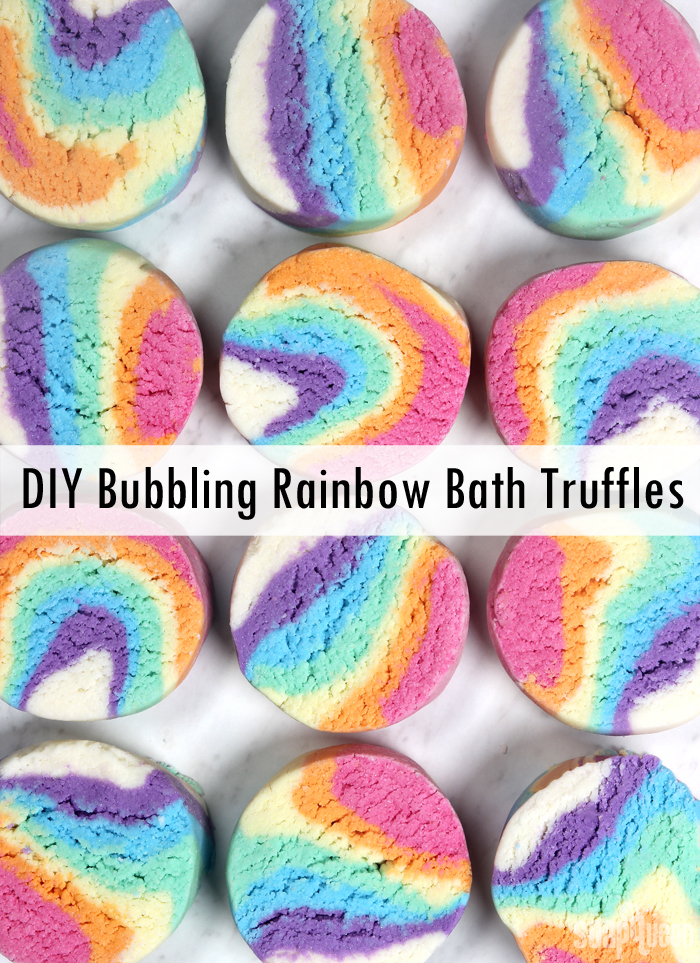
With St. Patrick’s Day a couple weeks away, I’ve been itching to make a rainbow-inspired project. Thus, Rainbow Bubbling Bath Truffles were born. The bars aren’t quite a bath bomb, bath melt, or bubble bar – they are a little bit of everything! The combination of sodium bicarbonate (baking soda) and citric acid creates a mild fizzing reaction. The addition of SLSA creates bubbles, while cocoa butter cubes and shea butter add moisture to the tub. The new Fruity Fusion Fragrance Oil gives the bath truffles a fruity scent, which smells delicious combined from the chocolatey smell from the cocoa butter. They smell a lot like chocolate covered gummies – yum!
When added to the tub, the bath truffles fall to the bottom because the butters make them quite heavy. Slowly, they start to fizz and disperse the skin-loving ingredients. If you want to activate the bubbles, hold the bar directly under the faucet once the tub is almost full. Break up small pieces of the bar in the running water. You can also place the bar into a fine mesh strainer and hold the strainer under the faucet to help activate the bubbles as well. The bubbles are modest because of the butter, but still cover the surface of the tub. If you’re looking for more bubbles, less fizz and less moisture in the tub, a more traditional solid bubble bar recipe (like the LoveSpell Solid Bubble Bath DIY) may be a better fit.
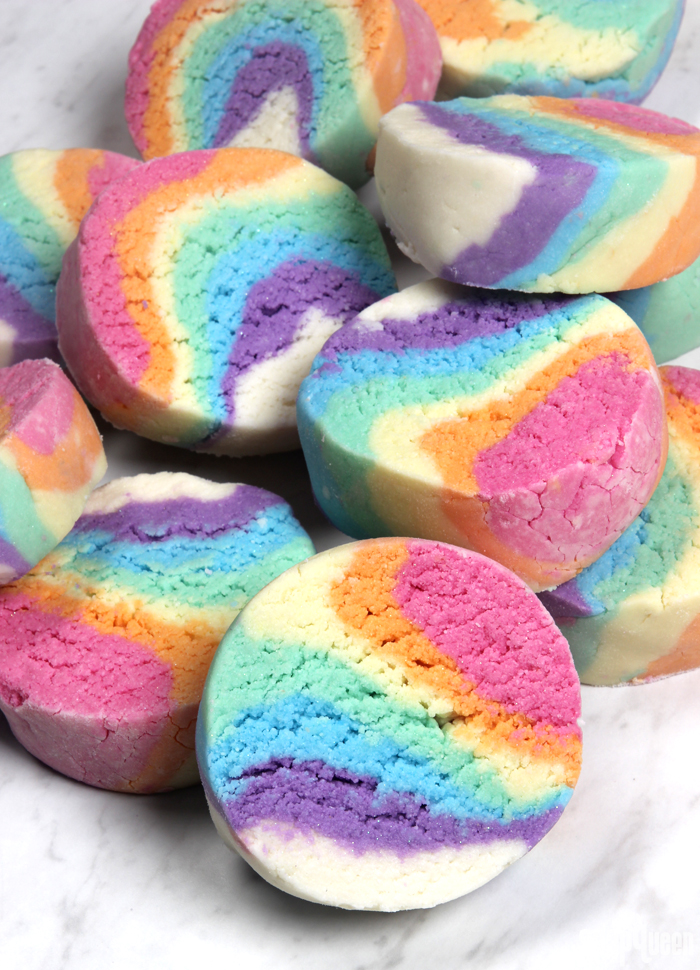
Typical solid bubble bath recipes can take a week or more to become firm. That’s because most of the moisture in solid bubble bath recipes comes from glycerin. One of the great things about this Bubbling Bath Truffle recipe is the bars harden within a few hours. The moisture in this recipe comes from shea and cocoa butter, rather than glycerin. Once the butters are completely cool, the bath truffles become firm. In our tests, this took about 3 hours. A small amount of glycerin makes the mixture slightly more moldable, and polysorbate 80 disperses the butters in the bath water.
While these bars are extremely vibrant thanks to micas, we found the colors don’t transfer on the tub. Polysorbate 80 prevents the colors from clumping up in the bath water. All the colors in this project can be found in the Rainbow Mica Sampler Pack. You can also use La Bomb Colorants. Oxides and pigments are not recommended. They are larger than micas, which make them harder to mix in and could transfer color to the tub or your skin.
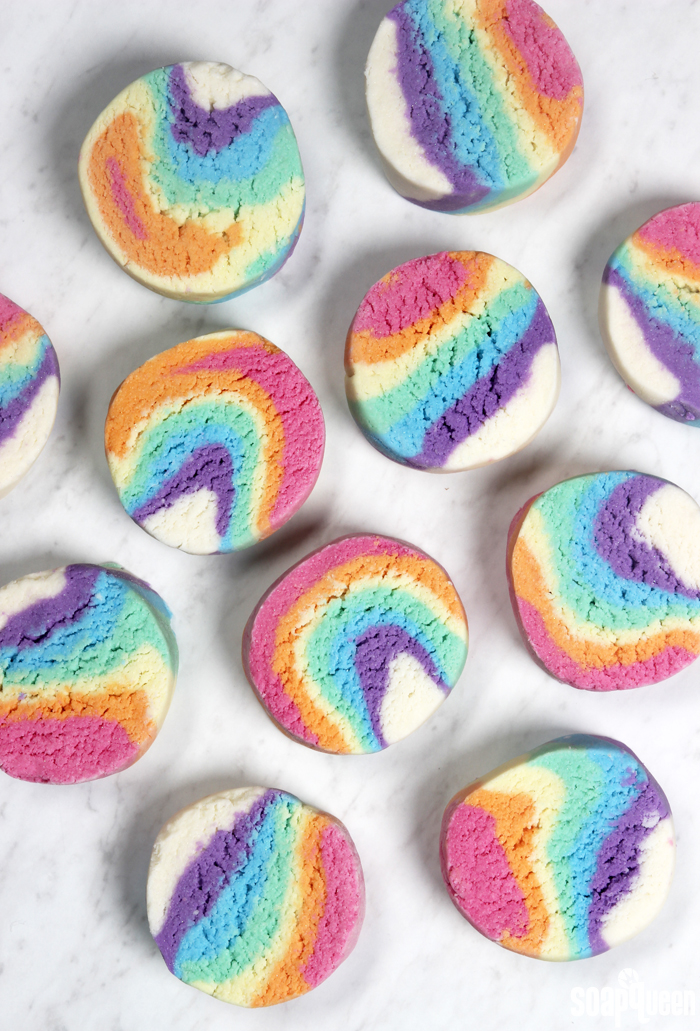
Testing and Recipe Notes –
These bath truffles took several trial and error batches – four to be exact. The first batch was placed in the Heavy Duty Column Mold and allowed to harden in the mold for a few hours. The final bars were an even circular shape; little did we know it was beginner’s luck! The problem with that batch? It was so hard to get the log out of the mold. The mixture expanded, making the liner really difficult to slide out. The bars also didn’t create many bubbles in the tub.
They looked great, but were difficult to make and didn’t behave like we wanted them to. After we tweaked the recipe to create more bubbles, we ran into the problem of the bars sticking to the liner. They were still hard to remove from the mold. You can see the sad third batch of bath truffles below. They stuck to the liner, and were also crumbly when cut. The crumbles still worked well in the tub though!
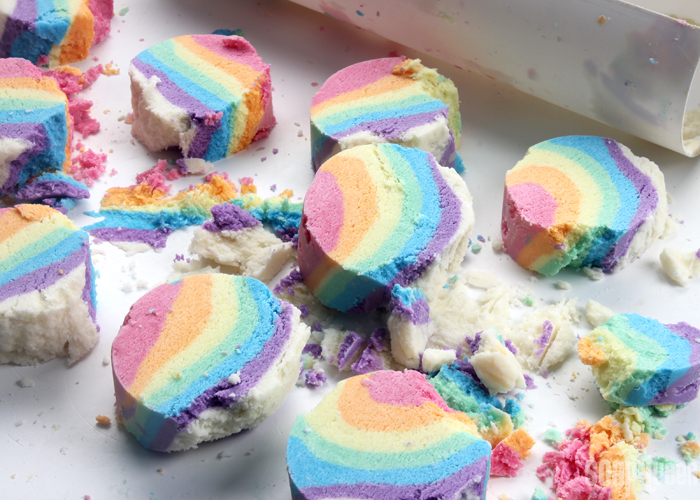 When formulating a recipe, not every batch turns out perfectly! This recipe took four trials to find a recipe and method that worked well together. This batch stuck to the mold liner.
When formulating a recipe, not every batch turns out perfectly! This recipe took four trials to find a recipe and method that worked well together. This batch stuck to the mold liner.
After testing, we decided to ditch the Heavy Duty Column Mold. While it did give the first batch an even, round shape, it just wasn’t working. It was extremely difficult to unmold the bars. It was also hard to find the perfect amount of time to leave the bars in the mold. If they were removed too soon, they were soft and stuck to the mold. If you wait too long, it was harder to umold and they were crumbly to cut. The compromise shown in this tutorial is using the liner to help shape the bars. Then, they are cut immediately while still soft.
If you want to substitute any ingredients in this recipe, it will change the texture of the dough. Changes to the recipe can affect how long you have to work with the dough, how firm the bars become, how easily the bars can be rolled and cut, how it behaves in the tub, etc. In general, I don't recommend making substitutions for the dry and wet ingredients in this recipe. If you do want to tweak the recipe, consider making a smaller batch with one color to see how the changes affect the texture of the dough and results in the tub.
What You’ll Need:
Optional: Mold Liner (for Heavy Duty Column Mold)
25 oz. Sodium Bicarbonate (Baking Soda) (41%)
7 oz. Citric Acid (12%)
13 oz. SLSA (21%)
2.5 oz. Cream of Tartar (4%)
1 tsp. Fine Iridescent Glitter
6 oz. Shea Butter (10%)
4.5 oz. Organic Cocoa Butter Cubes (7%)
1.5 oz. Liquid Glycerin (3%)
.5 oz. Polysorbate 80 (1%)
.6 oz. Fruity Fusion Fragrance Oil (1%)
Rainbow Mica Sampler Pack:
Raspberry Mica
Racing Stripe Orange Mica
Buttercup Mica
Kelly Green Mica
Caribbean Blue Mica
Queen’s Purple Mica

Click here to add everything you need for this project to your Bramble Berry shopping cart!
ONE: In a small heat-safe container, add the shea butter and cocoa butter cubes. Place the container in the microwave and melt the butters using 30-60 bursts. The cocoa butter takes a little while to melt. Be careful when removing it from the microwave, as it may be very hot.
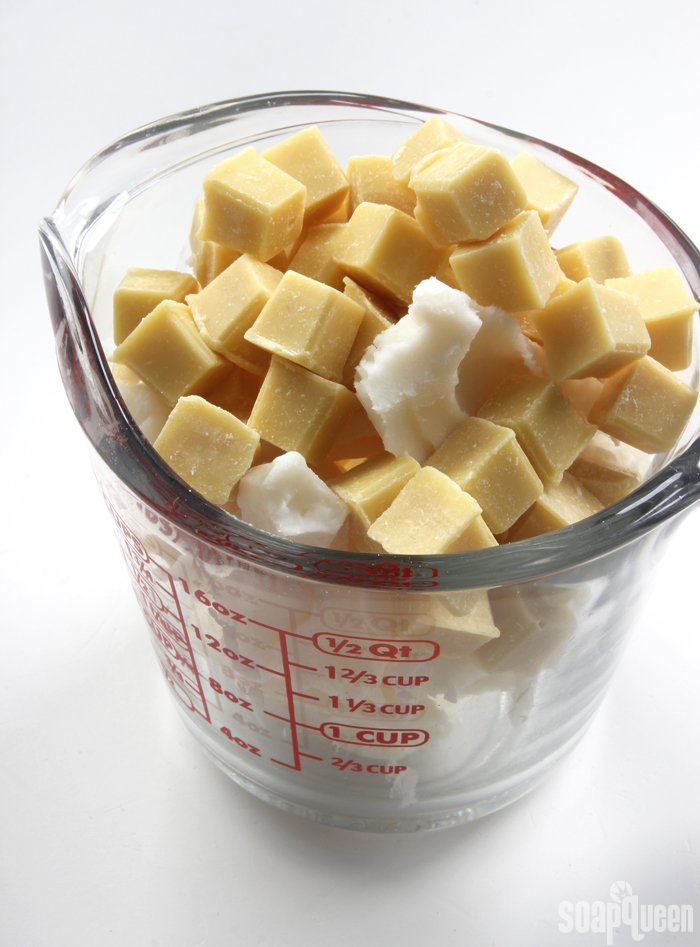
TWO: Add the Fruity Fusion Fragrance Oil, polysorbate 80 and glycerin to the melted butters. Use a spoon to thoroughly incorporate. Set aside.
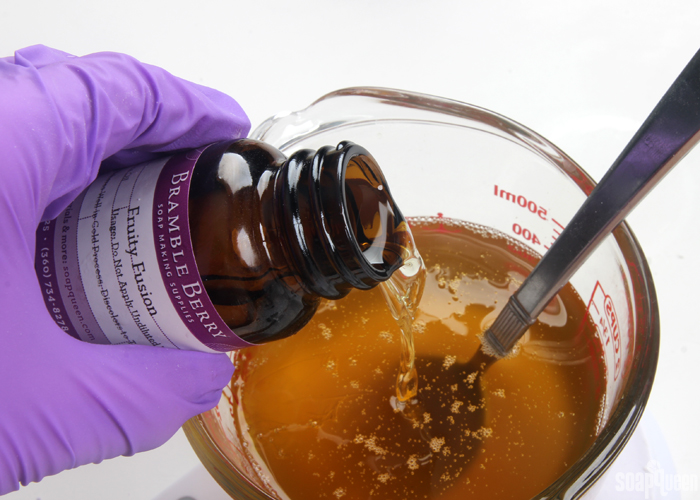
THREE: Place a fine mesh sifter over a large container. Add the baking soda, citric acid, cream of tartar and Fine Iridescent Glitter. Pour the ingredients through the sifter to get rid of chunks. Use a whisk to mix the ingredients together. Very carefully, add the SLSA to the large container (do not put it through the sifter). I recommend adding the SLSA very last. SLSA is extremely fine and powdery and can become airborne very easily. You may want to wear a mask during this step to avoid breathing in any SLSA. It is irritating if you breathe it in. Once all the ingredients have been added, slowly mix together the dry ingredients using a whisk.
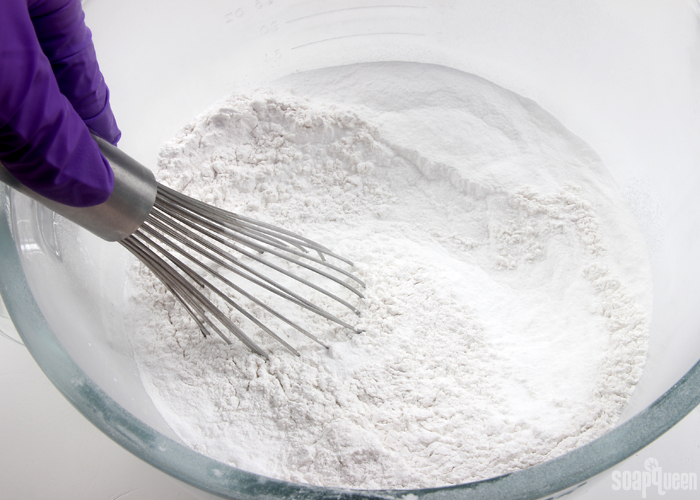
FOUR: Add about 1/3 of the melted butter mixture. I recommend adding the liquid ingredients to the powder when the liquids are about 180 ° F. This is quite hot, so I recommend using gloves to mix the liquid ingredients into the powder. The hotter the liquid ingredients are when added, the softer the final “dough” will be. Adding the liquid when it’s hot reduces the need to microwave it later. Use your hands to incorporate the liquid and powder ingredients together. If you prefer, you could also use a stand or hand mixer for this step, but I prefer using my hands.
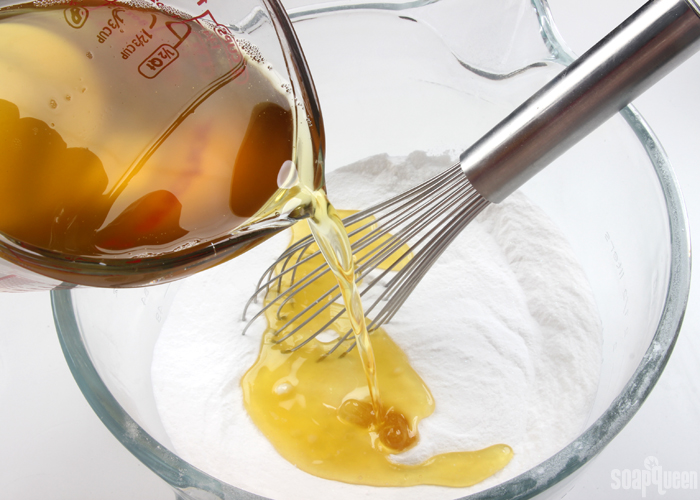
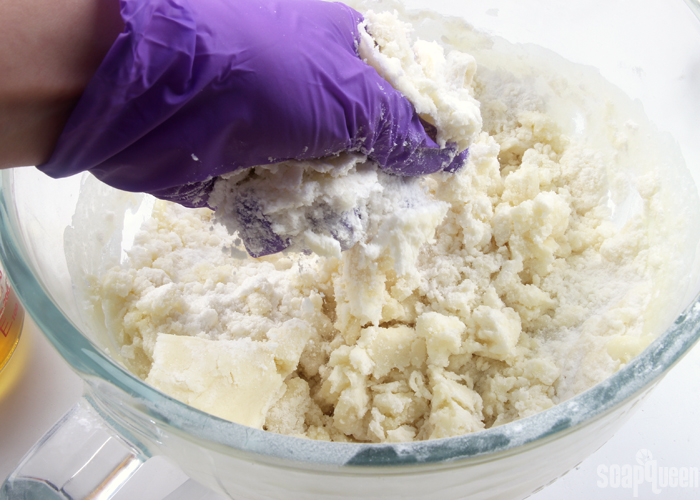
FIVE: Continue adding the liquid ingredients to the dry and mix together until fully incorporated. The final texture will be very similar to bread dough – soft, workable and slightly sticky. The texture of the mixture depends on the temperature of the butters. The warmer the dough, the softer it will be. We found a dough temperature of about 85-100 ° F is a great moldable texture. If your dough is cooler than that, place the entire mixture into the microwave for 10-20 seconds to warm it.
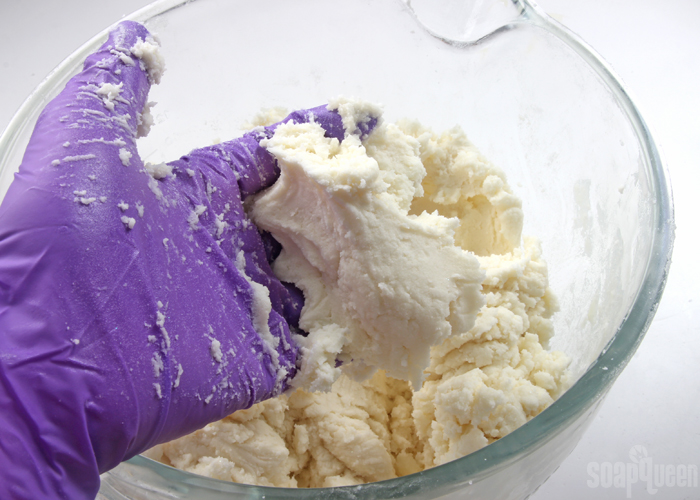
SIX: You will have about 60 ounces of mixture. Split the batch into 7 equal containers; each container should have about 8.5 ounces. I recommend weighing all the containers to make sure you have an equal amount, but you could eyeball it if you prefer.
SEVEN: To each container, add the following amounts of mica. If you prefer more pastel colors, use less. Add more mica if you prefer more vibrant colors. Use your hands to mix in the mica thoroughly until there are no streaks of color. I recommend mixing from lightest to darkest to avoid muddling the colors. You may want to change gloves when moving from warm to cool colors.
- Red/Pink: 1/8 tsp. Raspberry Mica
- Orange: 1/4 tsp. Racing Stripe Orange Mica
- Yellow: 1/4 tsp. Buttercup Mica
- Green: 1/8 tsp. Kelly Green Mica
- Blue: 1/8 tsp. Caribbean Blue Mica
- Purple: 1/4 tsp. Queen’s Purple Mica
- White: No colorant
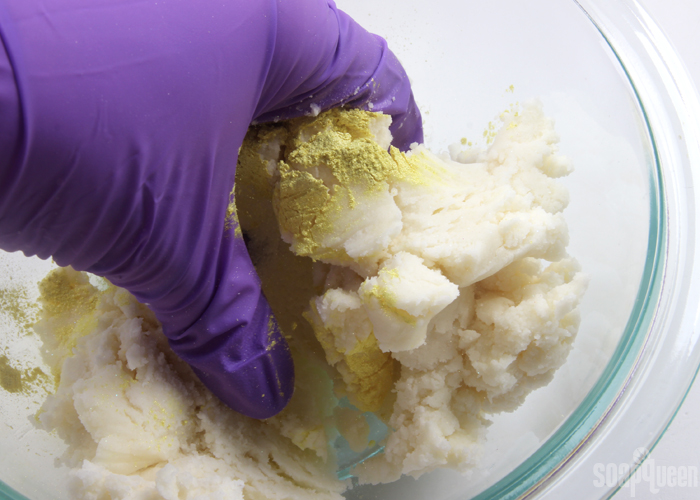
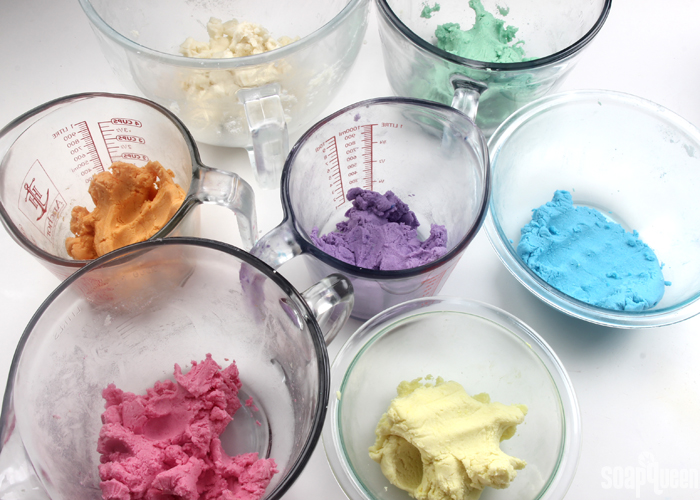
EIGHT: Once all the colors are mixed, it’s time to mold! Clean off your counter space to mold the mixture and create a log shape. Depending on your counter material, you may want to place a sheet of parchment or wax paper down to prevent the dough from sticking. Sprinkle your work surface with a bit of baking soda to prevent sticking. Working with the red/pink dough first, begin to form a long, flat dough shape. Place it on your work surface.
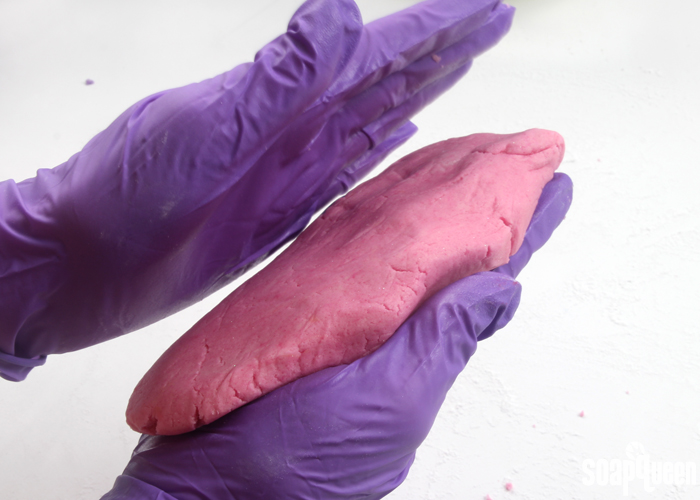
NINE: Continue making long, flat log shapes with the orange, yellow, green, blue and purple colors. Place each color on top of the last, and use your hands to gently press the colors together and form an even shape. Finally, place the uncolored portion of the mixture on top of the purple.
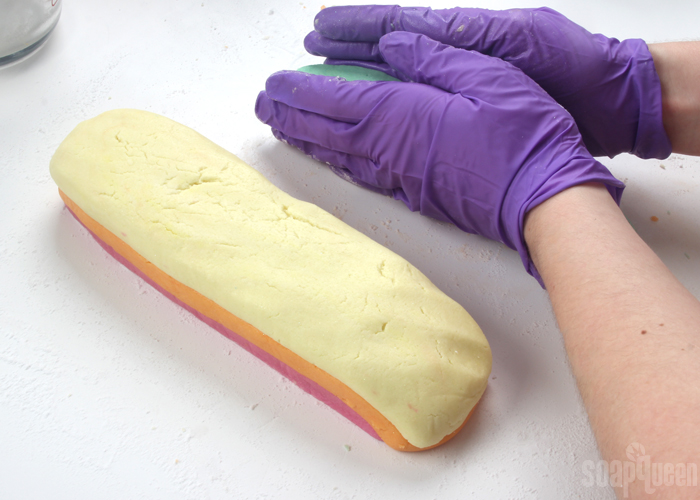
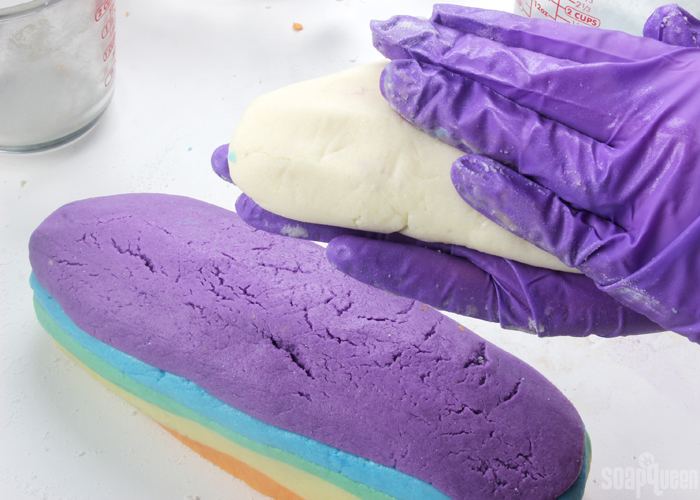
TEN: Use your hands to press the colors together into one log. The log should be about 12″. If you’d like your bars to be smaller, you can stretch the log into a longer shape, or create a shorter shape for bigger bars.
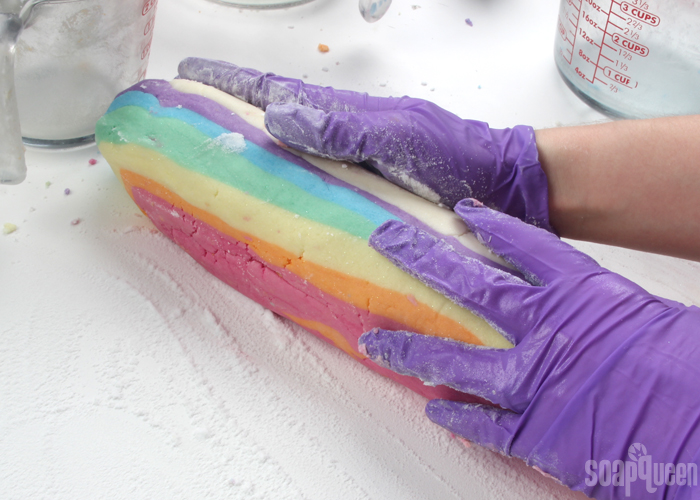 ELEVEN: If you’d like the colors to have a little more movement, very carefully twist the log. While twisting, be sure to press the log together to avoid large cracks or tears. This can be a little tricky, so feel free to skip it if you’re concerned with your log falling apart.
ELEVEN: If you’d like the colors to have a little more movement, very carefully twist the log. While twisting, be sure to press the log together to avoid large cracks or tears. This can be a little tricky, so feel free to skip it if you’re concerned with your log falling apart.
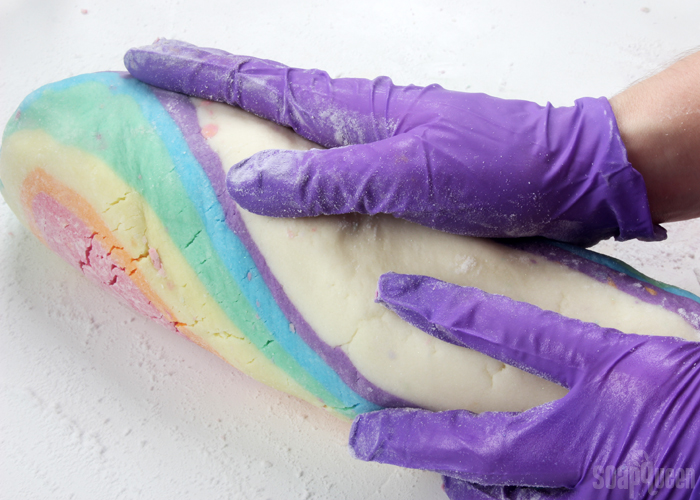
TWELVE: To help get a more even, circular shape, place the log into the liner for the Heavy Duty Column Mold. Squeeze the liner closed to create more condensed, even bars. This step can be skipped if you are happy with the shape created with rolling the log on the counter.
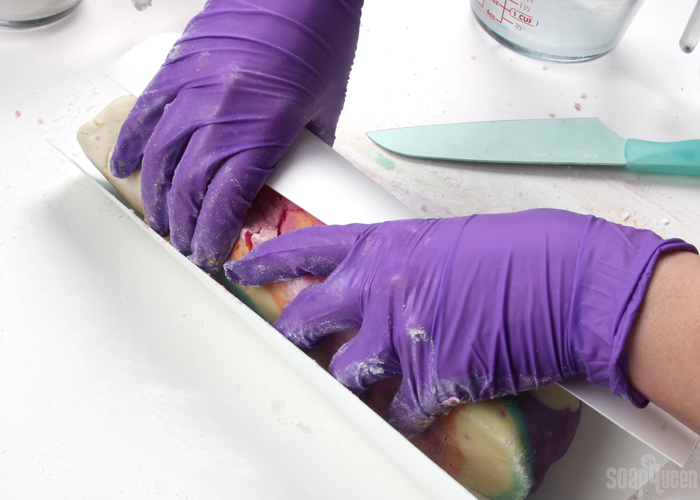
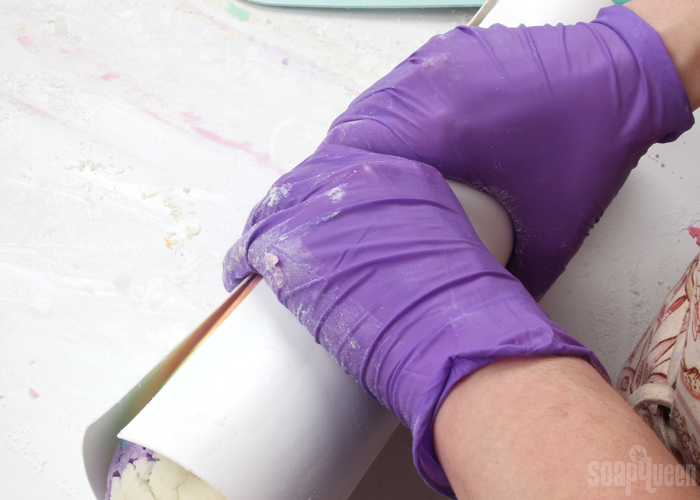
THIRTEEN: If you have not done so already, cover your surface with parchment or freezer paper. Carefully remove the log from the liner and use a sharp knife to cut the log into bars. Do so very gently, as the bottom of the bars may want to crumble a bit. If this happens, use your hands to reshape any crumbles. Rolling the log after each cut helps maintain a more even circular shape.
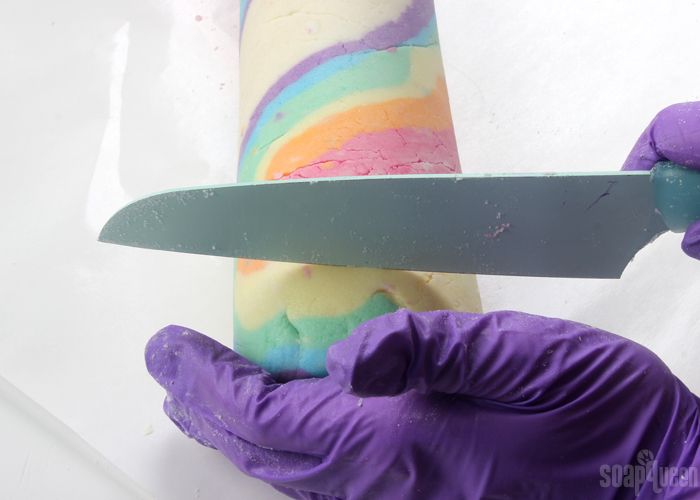
FOURTEEN: Very carefully place each bar face down on the parchment or freezer paper. Use your hands to reform any bars if needed. As the butters in the bath truffles cool, they become hard. It takes about 3-4 hours for the bars to become firm depending on your room temperature. It can be hard to wait, but be patient!
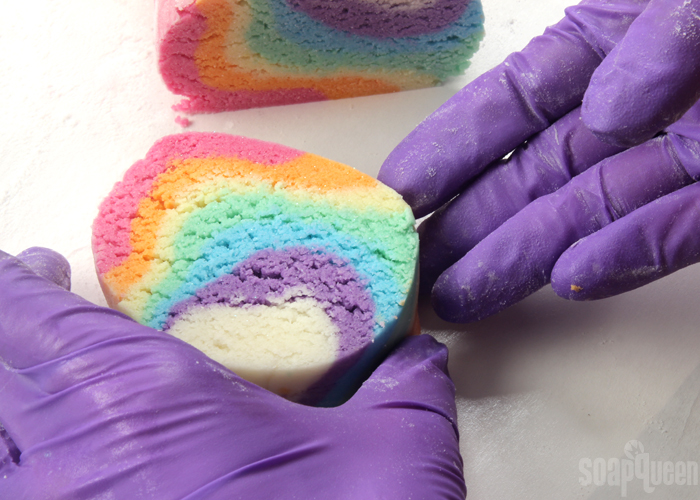
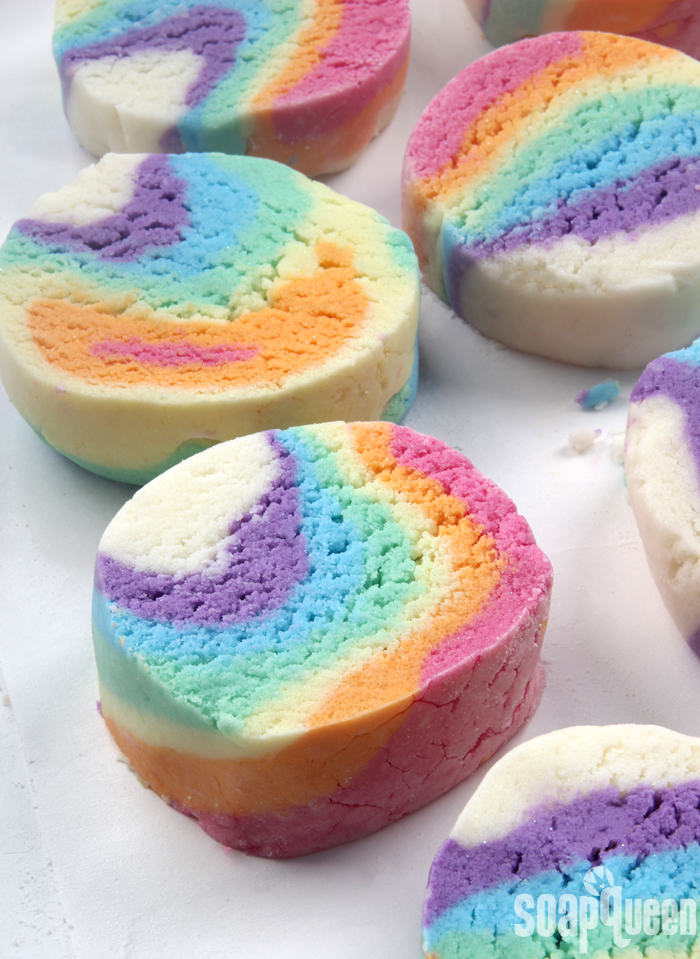
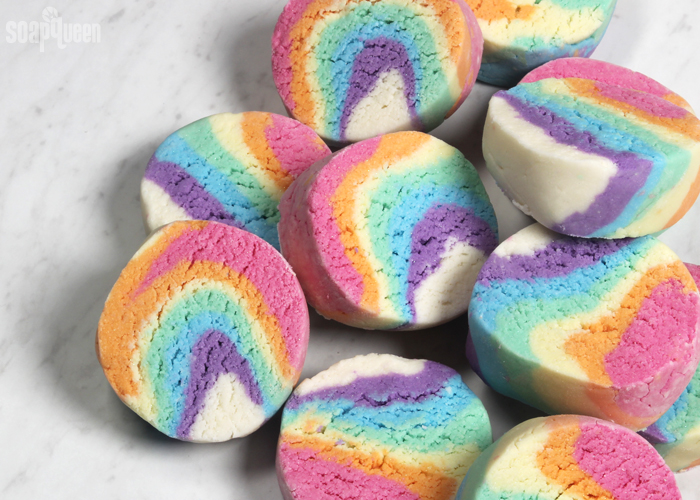
Once you’re ready to use the bath truffles, place them in the tub for a slow fizzing reaction with a small amount of foamy bubbles. If you want to “activate” more bubbles, hold the bar directly under the running bath faucet while breaking off small amounts of the bar.
DIY Rainbow Bubbling Bath Truffles
Author: Soap Queen
Recipe type: Bath Bomb/Bath Truffle
- Optional: Mold Liner (for Heavy Duty Column Mold)
- 25 oz. Sodium Bicarbonate (Baking Soda) (41%)
- 7 oz. Citric Acid (12%)
- 13 oz. SLSA (21%)
- 2.5 oz. Cream of Tartar (4%)
- 1 tsp. Fine Iridescent Glitter
- 6 oz. Shea Butter (10%)
- 4.5 oz. Organic Cocoa Butter Cubes (7%)
- 1.5 oz. Liquid Glycerin (3%)
- .5 oz. Polysorbate 80 (1%)
- .6 oz. Fruity Fusion Fragrance Oil (1%)
- Rainbow Mica Sampler Pack:
- Raspberry Mica
- Racing Stripe Orange Mica
- Buttercup Mica
- Kelly Green Mica
- Caribbean Blue Mica
- Queen's Purple Mica
- In a small heat-safe container, add the shea butter and cocoa butter cubes. Place the container in the microwave and melt the butters using 30-60 bursts. The cocoa butter takes a little while to melt. Be careful when removing it from the microwave, as it may be very hot.
- Add the Fruity Fusion Fragrance Oil, Polysorbate 80 and glycerin to the melted butters. Use a spoon to thoroughly incorporate. Set aside.
- Place a fine mesh sifter over a large container. Add the baking soda, citric acid, cream of tartar and Fine Iridescent Glitter. Pour the ingredients through the sifter to get rid of chunks. Use a whisk to mix the ingredients together. Very carefully, add the SLSA to the large container (do not put it through the sifter). I recommend adding the SLSA very last. SLSA is extremely fine and powdery and can become airborne very easily. You may want to wear a mask during this step to avoid breathing in any SLSA. It is irritating if you breathe it in. Once all the ingredients have been added, slowly mix together the dry ingredients using a whisk.
- Add about ⅓ of the melted butter mixture. I recommend adding the liquid ingredients to the powder when the liquids are about 180 ° F. This is quite hot, so I recommend using gloves to mix the liquid ingredients into the powder. The hotter the liquid ingredients are when added, the softer the final "dough" will be. Adding the liquid when it's hot reduces the need to microwave it later. Use your hands to incorporate the liquid and powder ingredients together. If you prefer, you could also use a stand or hand mixer for this step, but I prefer using my hands.
- Continue adding the liquid ingredients to the dry and mix together until fully incorporated. The final texture will be very similar to bread dough - soft, workable and slightly sticky. The texture of the mixture depends on the temperature of the butters. The warmer the dough, the softer it will be. We found a dough temperature of about 85-100 ° F is a great moldable texture. If your dough is cooler than that, place the entire mixture into the microwave for 10-20 seconds to warm it.
- You will have about 60 ounces of mixture. Split the batch into 7 equal containers; each container should have about 8.5 ounces. I recommend weighing all the containers to make sure you have an equal amount, but you could eyeball it if you prefer.
- To each container, add the following amounts of mica. If you prefer more pastel colors, use less. Add more mica if you prefer more vibrant colors. Use your hands to mix in the mica thoroughly until there are no streaks of color. I recommend mixing from lightest to darkest to avoid muddling the colors. You may want to change gloves when moving from warm to cool colors.
Red/Pink: ⅛ tsp. Raspberry Mica
Orange: ¼ tsp. Racing Stripe Orange Mica
Yellow: ¼ tsp. Buttercup Mica
Green: ⅛ tsp. Kelly Green Mica
Blue: ⅛ tsp. Caribbean Blue Mica
Purple: ¼ tsp. Queen's Purple Mica
White: No colorant - Once all the colors are mixed, it's time to mold! Clean off your counter space to mold the mixture and create a log shape. Depending on your counter material, you may want to place a sheet of parchment or wax paper down to prevent the dough from sticking. Sprinkle your work surface with a bit of baking soda to prevent sticking. Working with the red/pink dough first, begin to form a long, flat dough shape. Place it on your work surface.
- Continue making long, flat log shapes with the orange, yellow, green, blue and purple colors. Place each color on top of the last and use your hands to gently press the colors together, and form an even shape. Finally, place the uncolored portion of the mixture on top of the purple.
- Use your hands to press the colors together into one log. The log should be about 12". If you'd like your bars to be smaller, you can stretch the log into a longer shape, or create a shorter shape for bigger bars.
- If you'd like the colors to have a little more movement, very carefully twist the log. While twisting, be sure to press the log together to avoid large cracks or tears. This can be a little tricky, so feel free to skip it if you're concerned with your log falling apart.
- To help get a more even, circular shape, place the log into the liner for the Heavy Duty Column Mold. Squeeze the liner closed to create more condensed, even bars. This step can be skipped if you are happy with the shape created with rolling the log on the counter.
- If you have not done so already, cover your surface with parchment or freezer paper. Carefully remove the log from the liner, and use a sharp knife to cut the log into bars. Do so very gently, as the bottom of the bars may want to crumble a bit. If this happens, use your hands to reshape any crumbles. We found rolling the log after each cut helped maintain a more circular shape.
- Very carefully place each bar face down on the parchment or freezer paper. Use your hands to reform any bars if needed. As the butters in the bath truffles cool, they become hard. It takes about 3-4 hours for the bars to become firm depending on your room temperature. It can be hard to wait, but be patient!
- Once you're ready to use the bath truffles, place them in the tub for a slow fizzing reaction with a small amount of foamy bubbles. If you want to "activate" more bubbles, hold the bar directly under the running bath faucet while breaking off small amounts of the bar.
3.3.3077
The post DIY Rainbow Bubbling Bath Truffles appeared first on Soap Queen.
Keine Kommentare:
Kommentar veröffentlichen